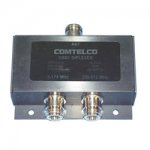Prospect62
Member
Hey guys, I'm sorry if this is a duplicate question. I've done some reading here and I just want to get opinions on my particular needs, if you guys have time.
I have two GE Orion radios. One VHF 150-174 and one 800 MHz EDACS. I live and work about two miles from the EDACS tower site and my county's VHF system is very strong. I will be using these for monitoring purposes 99% of the time. I also have a low band radio that I will be using. This will be a vehicle installation and I will be installing two 1/4 wave NMO antennas on the roof of my vehicle. I'd like to tie the VHF and 800 together into one antenna and use the other NMO for the low bander.
Could I combine the VHF and 800 radios into one antenna using this:
TNC Male Plug to Y 2X TNC Jack Female Splitter Combiner Pigtail RG316 1M2F | eBay
OBVIOUSLY with the male and female ends reversed. Or could I use this:
RF Connector Combiner Splitter 2 BNC M to BNC F | eBay
OBVIOUSLY with some TNC to BNC adapters.
Or, should I pony up and get a more expensive combiner/splitter? If so, suggestions on that? Most of the ones that have been recommended on here before are no longer available as the threads and links are like 5 years old.
Thanks for any help!
I have two GE Orion radios. One VHF 150-174 and one 800 MHz EDACS. I live and work about two miles from the EDACS tower site and my county's VHF system is very strong. I will be using these for monitoring purposes 99% of the time. I also have a low band radio that I will be using. This will be a vehicle installation and I will be installing two 1/4 wave NMO antennas on the roof of my vehicle. I'd like to tie the VHF and 800 together into one antenna and use the other NMO for the low bander.
Could I combine the VHF and 800 radios into one antenna using this:
TNC Male Plug to Y 2X TNC Jack Female Splitter Combiner Pigtail RG316 1M2F | eBay
OBVIOUSLY with the male and female ends reversed. Or could I use this:
RF Connector Combiner Splitter 2 BNC M to BNC F | eBay
OBVIOUSLY with some TNC to BNC adapters.
Or, should I pony up and get a more expensive combiner/splitter? If so, suggestions on that? Most of the ones that have been recommended on here before are no longer available as the threads and links are like 5 years old.
Thanks for any help!
Last edited:


